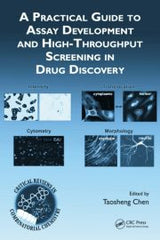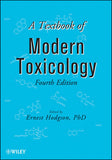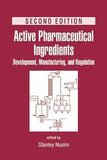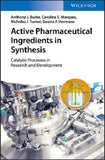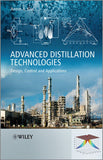A Practical Guide to Assay Development and High-Throughput Screening in Drug Discovery by Taosheng Chen
A Practical Guide to Assay Development and High-Throughput Screening in Drug Discovery
Features
- Integrates the knowledge of experts in biology, chemistry, informatics, instrumentation, automation, technology development, and project management
- Enables researchers in industrial and academic settings to find the most efficient way to carry a project from start to finish
- Identifies critical targets that are of relevance to drug discovery
- Discusses the components of the HTS process and provides step-by-step instructions
- Examines emerging technologies and systems
Summary
The development of suitable assays, the integration of appropriate technology, and the effective management of the essential infrastructure are all critical to the success of any high-throughput screening (HTS) endeavor. However, few scientists have the multidisciplinary experience needed to control all aspects of an HTS drug discovery project. A Practical Guide to Assay Development and High-Throughput Screening in Drug Discovery integrates the experience of diverse experts who offer fundamental and practical guidance across numerous situations.
The book first discusses assay developments for important target classes such as protein kinases and phosphatases, proteases, nuclear receptors, G protein-coupled receptors, ion channels, and heat shock proteins. It next examines assay developments for cell viability, apoptosis, and infectious diseases. The contributors explore the application of emerging technologies and systems, including image-based high content screening, RNA interference, and primary cells. Finally, they discuss the essential components of the integrated HTS process, such as screening automation, compound library management, the screening of natural products from botanical sources, and screening informatics.
Designed to motivate researchers to bring further advances to the field, this volume provides practical guidance on how to initiate, validate, optimize, and manage a bioassay intended to screen large collections of compounds. Drawing on the knowledge from experts actively involved in assay development and HTS, this is a resource that is both comprehensive and focused.
Table of Contents
Assay Development for Protein Kinases and Phosphatases, J. F. Glickman
Fluorescence-Based Biochemical Protease Assay Formats, J. Woelcke and U. Hassiepen
Assay Development for Nuclear Hormone Receptors, C. Bai and E. N. Johnson
Assay Development for G Protein-Coupled Receptors and Ion Channels, J. G. McGivern, Y. Qian, and P. H. Lee
Assay Development for Heat Shock Proteins, Z. Gao and S. Fong
Assay Development for Cell Viability and Apoptosis for High Throughput Screening, T. L. Riss, R. A. Moravec, and A. L. Niles
Assay Development for Antimicrobial Drug Discovery, H. H. Xu
Image-Based High Content Screening, Y. Feng and C. J. Wilson
Application of RNA Interference in Drug Discovery, N. M. Wolters and J. P. MacKeigan
Assay Development Using Primary and Primary-Like Cells, S. Corazza and E. J. Wade
Screening Automation, W. Zheng and C. Z. Chen
Compound Library Management, D. Nie
Unique Discovery Aspects of Utilizing Botanical Sources, S. P. Manly, T. Smillie, J. P. Hester, I. Khan, and L. Coudurier
Screening Informatics, S. C. Schürer and N. F. Tsinoremas
Index
Related Products
-
A Textbook of Modern Toxicology,...
8,942.00
10,520.00 -
Active Pharmaceutical Ingredient...
3,200.00
3,495.00 -
Active Pharmaceutical Ingredient...
14,850.00
17,500.00 -
Advanced Distillation Technologi...
13,500.00
15,000.00 -
Aesthetics Exposed: Mastering Sk...
17,000.00
- Architecture & Construction Management Books
- Biochemistry, Bioengineering and Biotechnology Books
- Books on Analytical Techniques, GC MS, LC, TLC, HPLC, NMR Spectroscopy
- Books on Water and Wastewater Treatment, Analysis Water Treatment Plants
- Chemical Technology, Organic Chemistry, Chemical Synthesis and Chemical Analysis Books
- Cosmetics Science, Cosmetics Formulations, Manufacture and their Analysis Books
- Drugs and Pharma Science Books
- Essential Oils, their Analysis, Natural Products Extraction, Distillation , Isolates Related Books
- Flavor Science, Flavor Analysis, Flavor Creation, Food Flavors Books
- Food Science and Technology, Baking , Food Ingredients , Food Quality , Food Regulations
- Formulations of Perfumes for Agarbatti, Air Freshners, Soaps & Detergents, Fabric Softeners , French style Perfumes, Attars , OUD, Fine Fragrances
- Fragrances, Scents, Attars , Perfumery and Aroma Chemicals Books
- Herbal, Ayurvedic, Medicinal Plants and Aromatic Plants Books
- Law Books
- Major Reference Works (MRWS) Sets - MultiVolume Sets
- Medical Books
- Medical Journals Wolters Kluwer | Medknow India
- NEW ARRIVALS
- Perfumer's Resources
- Special Indian Reprint !



